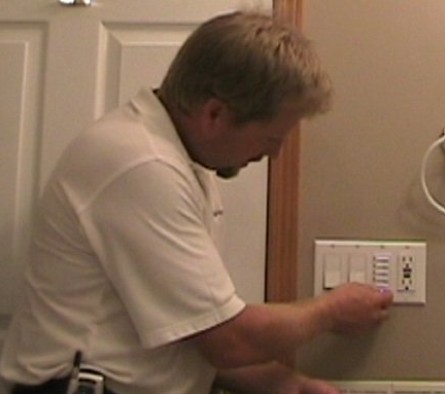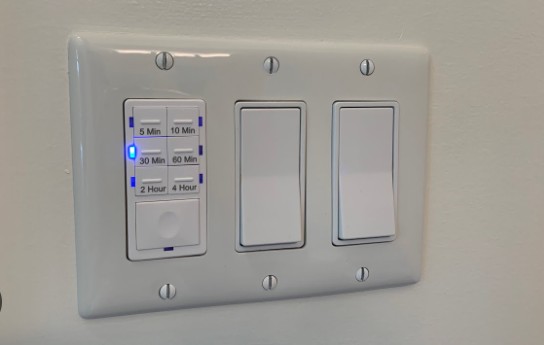For convenient operation, bathroom fans are typically connected to the main light switch. However, there’s one important question you ought to answer before installation, does a bathroom fan need an isolation switch?
The decision to install an isolation switch for a bathroom fan ultimately depends on individual preferences and circumstances. You will need one if you want to isolate your fan and be able to turn the fan on and off without interfering with the bathroom lights and vice versa.
Isolation switches offer many benefits we will explore in this post, so keep reading.

What Is An Isolation Switch For Bathroom Fans?
An isolation switch, also known as an extractor fan isolation switch or a fan isolation pull cord switch, is a specific type of switch designed for controlling the power supply to a bathroom fan. It is commonly installed in bathrooms to provide a convenient and safe way to turn the fan on and off.
The primary purpose of an isolation switch is to allow users to easily isolate and disconnect the power to the fan when needed, such as during maintenance or repairs. It provides a dedicated switch typically located near the fan or in a convenient location within the bathroom.
The isolation switch is usually a pull-cord switch, similar to the ones used for ceiling lights in bathrooms. It typically consists of a cord attached to a switch mechanism mounted on a wall plate.
Pulling the cord operates the switch giving you control over the power supply to the fan. Pulling the cord once turns the fan on, and pulling it again turns it off.
Does A Bathroom Fan Need An Isolation Switch?
The decision to install an isolation switch for a bathroom fan ultimately depends on your preferences and circumstances. However, installing an isolation switch for a bathroom fan is generally considered good practice.
An isolation switch allows you to control the fan independently from the lights, thus improving energy efficiency. It also enhances comfort, convenience, aids in odor control, and facilitates moisture management.
However, before installation, you should consider factors like installation complexity, space constraints, maintenance requirements, noise concerns, and building code regulations. It is advisable to consult with an electrician or professional to assess feasibility and ensure compliance with local codes.
Reasons to Install An Isolation Switch in Your Bathroom Fan
Below is why your bathroom fan requires an isolation switch.
1. Enhanced Safety
An isolator switch serves as a disconnecting device that physically breaks the electrical connection between the fan and the mains electricity supply. This isolation reduces the risk of electric shock during maintenance, repair, or cleaning of the fan, letting you work on the fan without live electricity.
It also reduces the likelihood of accidental activation by ensuring the fan remains off when not in use, minimizing the risk of operating it unintentionally. This is particularly vital if you have children at home.
An isolation switch also provides a quick and convenient means to shut off the power supply to the fan. This comes in handy in the event of a malfunction or an emergency situation related to the fan, such as excessive heat or abnormal noise.
2. Convenience and Control
Operating your bathroom fan becomes effortless with a dedicated switch as it lets you turn it on or off with a simple flip. This eliminates the need to locate and manipulate other controls or switches that might be less accessible or harder to reach.
You can also turn your fan on or off as needed, regardless of the state of other bathroom fixtures or lighting. This independence is instrumental when you want to use the fan without turning on other lights or when you need ventilation without operating additional devices.
3. Tailored Usage
A separate switch enables you to customize the usage of the bathroom fan to your specific needs. You can operate it for longer or shorter durations depending on the level of ventilation required, the presence of odors, or the amount of moisture in the air.
This flexibility allows you to optimize the fan’s performance according to the bathroom conditions.
4. Energy Efficiency
An isolator switch provides an easy way to conserve energy by allowing you to turn off the bathroom fan when it’s not needed. This can be particularly beneficial when leaving the bathroom or when the fan has completed its ventilation task.
Controlling your fan’s usage can reduce electricity consumption and lower utility bills.
5. Noise Control
Bathroom fans can be noisy, which may be undesirable, especially during quiet moments or when you’re trying to sleep nearby. With an isolator switch, you have the ability to turn off the fan when silence is desired, providing a more peaceful environment.
6. Enhanced Privacy
You can run the bathroom fan for ventilation in your shared bathroom or bedroom without disturbing others by turning on bright lights.

Why Shouldn’t You Install an Isolator Switch on Your Bathroom Fan?
While there are plenty of reasons to have an isolation switch for your bathroom fan, it comes with certain constraints. These are:
a. Cost Considerations
Installing an isolator switch may require the services of a licensed electrician, especially if it involves additional wiring or modifications. If that’s the case, you must factor the cost of professional installation into your decision-making process unless you can handle the installation yourself.
Furthermore, consider the potential benefits of installing an isolator switch compared to its cost. It may be worth the investment if the added convenience, control, and safety outweigh the upfront expense.
However, if the benefits seem minimal or do not align with your needs, you might choose to forgo the isolator switch and allocate your resources elsewhere.
b. Space Limitations
Finding a suitable location for an isolator switch may be challenging if your bathroom has limited wall space due to fixtures, cabinets, or other obstructions. You may need to rearrange existing elements to install the switch, which could compromise the aesthetics and functionality of your bathroom design.
Installing an isolator switch might be impractical or inconvenient if the available wall space is not conveniently located near the bathroom fan. Placing the switch too far away from the fan could undermine the purpose of having dedicated control and defeat the convenience it provides.
c. Compatibility Issues
Ensure your bathroom fan is compatible with this type of switch before installing an isolator switch. Some fans lack the wiring or connections to accommodate an isolator switch.
Additionally, bathroom fan units are not designed to work with an isolator switch. This could be due to the fan’s construction, control mechanisms, or integrated switches.
Installing an isolator switch in such cases might require modifying the fan unit or replacing it with a model that supports an isolator switch. Consult a professional electrician if you need clarification on the compatibility of your bathroom fan with an isolator switch.
d. Minimal Usage Or Low-Risk Environment
An isolator switch may be unnecessary in rarely used bathrooms like a guest bathroom. The necessity for an isolator switch may also be reduced in a bathroom with proper ventilation, good air circulation, or one not prone to excessive moisture buildup, odors, or mold growth.
You can also do without an isolator switch if your bathroom has windows that provide sufficient natural ventilation. The same is true if you have an alternative ventilation system, such as an exhaust vent connected to a central HVAC system.
What Do Building Codes Say About Isolation Switches For Bathroom Fans?
Local regulations and jurisdictions determine building codes regarding isolation switches for bathroom fans. It is crucial to consult the specific codes and regulations applicable in your area, as they may differ from general guidelines.
However, below are some common considerations found in building codes regarding isolation switches for bathroom fans:
i) Accessibility
The isolation switch should be easily accessible and located in a position you can reach. It is typically installed outside the bathroom or in an adjacent area.
ii) Distance from the Shower or Bathtub
The switch should be installed at a suitable distance from the shower or bathtub to ensure it is not within the reach of someone using these facilities. This is to prevent any risk of electrical hazards in wet environments.
iii) Clear Labeling
The isolation switch must be clearly labeled and readily identifiable as the control for the bathroom fan. This ensures it can be easily located and operated when needed.
iv) Disconnecting Power Supply
The isolation switch should be capable of disconnecting the power supply to the bathroom fan completely. This ensures the fan is effectively turned off for maintenance, cleaning, or in case of emergencies.
Should A Fan Isolator Switch Be On Or Off?
A fan isolator switch should typically be in the “off” position when the fan is not in use. On the other hand, it should be in the “on” position when using the fan to supply power to the fan and allow it to function as intended.
By switching the fan isolator to the “off” position, you effectively disconnect the power supply to the fan, ensuring it is not operating when you don’t want the fan running.

Where Should Bathroom Fan Isolator Switch Be Located?
It is common practice to install the isolator switch outside the bathroom. This ensures the switch is easily accessible and not exposed to the damp or humid environment inside your bathroom, reducing the risk of electrical hazards.
Moreover, it is usually installed in an adjacent area, such as a hallway, near the entrance of the bathroom. This allows convenient access while maintaining a safe distance from water sources, such as showers or bathtubs.
The location should be visible and accessible, and appliances, furniture, and any other object should not obstruct it.
Regarding height placement, install it at a height most individuals can easily reach, including people with mobility limitations. The typical height range is between 1.2 meters (4 feet) to 1.8 meters (6 feet) from the floor.
In Summary, Does A Bathroom Fan Need An Isolation Switch?
Decide if a fan isolation switch is necessary for your bathroom by considering the benefits, drawbacks, and personal needs and preferences. However, generally, it offers more advantages than constraints, making it worth installing.
Also, read:
